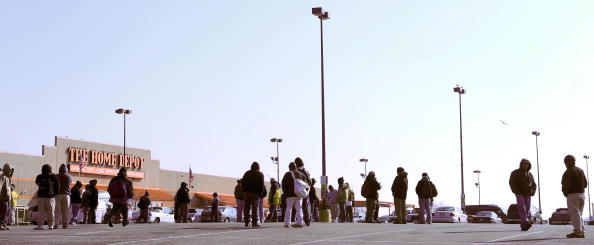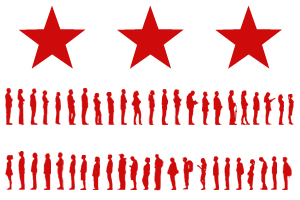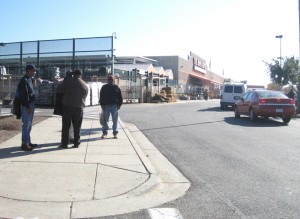Division of Labor: Immigration and D.C. Unemployment
While much of the country struggles with job creation, D.C. is in the unique position of having more jobs than residents. So why are some D.C. neighborhoods facing Depression-era unemployment rates? DCentric examines how D.C.’s healthy economy has left out so many Washingtonians and what some are doing to close the unemployment gap. Fourth in a series.

Tim Sloan / AFP/Getty Images
Day laborers wander the parking lot of Home Depot looking for work on Jan. 29, 2009. Day laborers have gathered at the site for years.
Like they do on most mornings, Jose Matute and Allan Hernandez recently stood in the parking lot of Home Depot in Northeast D.C. Dozens of men, mostly Latinos, joined them. They were scattered throughout the parking lot, waiting for work.
A small SUV pulled up. About six men approached, and one got in. The other five returned to their spots, hoping a job would come their way.
“We work here because we have to work,” Matute, 29, said.
While construction has slowed nationwide, development marches on in a number of D.C. neighborhoods. Meanwhile, predominately African-American wards are facing Depression-era unemployment. There is a perception among some that immigrant workers are getting hired over non-immigrants in D.C., or that they’re willing to work for less, and that this is exacerbating high unemployment.

Image: Carrie Moskal / WAMU
"Division of Labor" is DCentric's examination of D.C.'s unemployment disparity.
“They’re hiring the Spanish and people from other countries,” said Ward 8 resident Sylvester Anderson. Three months ago, he completed a 14-week long construction-training program through the city and said he’s been unable to get a steady job since. He said he spends his weekdays going to construction sites to look for work applying for jobs online.
Valarie Ashley runs Southeast Ministry, a nonprofit that provides adult education and job training in Ward 8, which is 92 percent black. She said the issue of race comes up often in conversations with unemployed African Americans who say they go by work sites where most workers are Latino.
There is a “tension,” she said. “Whenever resources are diminished, people highlight differences. When all is well, people don’t pay as much attention.”
The Numbers and the Jobs
Entry-level jobs and positions not requiring advanced degrees aren’t abundant in D.C. Audrey Singer of the Brookings Institution said it’s unclear whether recent immigrants have made it more difficult for native-born citizens to find low-wage work.
“It sort of depends on who you talk to,” she said. “There’s a big debate going on… I think the evidence points to the fact that [nationally] in low-wage jobs, there has been competition” between U.S. born workers and immigrants.
It’s hard to say what impact immigrants have had in D.C. Since the 1980s, communities such as Ward 8 have consistently faced nearly double the unemployment rate than that of D.C. as a whole. The number of immigrants in D.C. has increased in the past 10 years by about 11 percent with most hailing from Latin American, according to Census figures.
The Pew Hispanic Center estimates there were about 25,000 undocumented immigrants in D.C. in 2009, making up 4.1 percent of the city’s population and 6.1 percent of the workforce.
What’s Race Got To Do With It?
The national debate over immigration often becomes intertwined with race. Typically anti-immigrant sentiments are depicted as coming from whites, and they’re typically targeted at Latinos. In D.C., that’s not the case. Most of D.C.’s immigrants are Latino, and most of those living in communities with very high unemployment are black.
“This is a classic example of divide and conquer” in that blacks and Latinos are pitted against one another rather than working together on issues that affect both communities, said Pedro Cruz. He is a Georgetown University graduate student running a language exchange program between Georgetown students and day laborers.
Read More:
Explaining D.C.’s Unemployment Disparities
The Gap Between Skills and Jobs
Immigration and D.C. Unemployment
Cruz also used to be a union organizer advocating for day laborers in the Home Depot parking lot. He said many of the subcontractors who would come by to hire men for work would claim “that they want to hire African Americans to do construction work, but that they can’t pass drug tests or have the liability issues. Those are the excuses I’d hear,” Cruz said.
Arturo Griffiths is a community organizer working with day laborers on behalf of DC Jobs with Justice, a coalition of pro-labor groups. He is black and from Latin America, so he hears “it from both sides.” He noted there is frustration toward immigrant workers from some African Americans. But such sentiments aren’t as widespread as in some neighboring communities, such as in Prince William County, Va., which passed a tough immigration enforcement law in 2007.
Leo Alexander, a D.C. activist who unsuccessfully ran for mayor, has been very vocal in his opposition to illegal immigration.
“Nobody wants to deal with it because they look at this black population as being undereducated, and for whatever reason just think they don’t want to work, but that’s not the case,” Alexander said. “They have worked those jobs for generations, prior to this new influx [of immigrants], and they want those jobs back. They just don’t want to do it for illegal immigrant wages.”

Elahe Izadi / DCentric
A group of African American day laborers speak with community organizer Arturo Griffiths outside of Home Depot's parking lot. Most day laborers assembled are Latino immigrants, but not all.
John Henry, 60, who has been coming to the Home Depot parking lot for about five years, doesn’t attribute his lack of a steady job to the immigrants’ presence.
“You can’t get bent out of shape and blame people,” said Henry, an African-American native Washingtonian. “That’s scapegoating.”
“The idea that immigrants are taking the jobs is very much related to who’s doing the hiring,” Singer said. Such arguments “make the immigrants sound very active in the process, and that’s not really what’s happening.”
Employer preferences toward immigrants can be the result of many factors; networks funnel immigrants into certain professions and they become redefined as “immigrant jobs.” It also may have less to do with race than one would think; nationally, Hispanic immigrants have a lower unemployment rate than U.S.-born Hispanics, according to the Pew Hispanic Center.
Steven Camarota of the Center for Immigration Studies said employers might prefer hiring immigrant workers because there’s a perception that they’d be willing to endure poor working conditions or work for less than U.S. born workers.
“Companies and individuals are looking to make money, and they’re trying to make money with low-wage workers,” Griffiths said. “[These immigrants] are people who have to do whatever to survive.”
D.C. Chamber of Commerce President Barbara Lang said most D.C. employers are fair and just “want to hire the best person for the job.” But, she added, “I will never discount that there is some stereotyping gets done.”
Hard for Everyone

Elahe Izadi / DCentric
A day laborer waits for work in the parking lot of Home Depot. A construction site looms in the background, a sign of continuing development in D.C.
Before 2009, Ben Jamen would recall days when nearly 150 men would be in the Home Depot parking lot and most would find work. The 28-year-old now comes to the site about once a month for temporary jobs, and has noticed a considerable slow down.
Matute agreed. “It was a lot different” a few years ago, he said. “Things were very good. I worked regularly.”
Coming to the Home Depot parking lot and hoping to get a job, day after day, isn’t anyone’s dream, really. Many said they come to the site because they see few alternatives.
“The Americans who don’t work, it’s because they don’t want to do this work,” Matute said. “They have papers, know English. They can go to companies and get jobs.”
Immigrant day laborers don’t always get paid for the work they complete. Wage theft is a big problem, Griffiths said, and he often finds himself trying to recoup back pay on behalf of workers.
Some workers have aspirations beyond the parking lot, such as Hernandez: the 22-year-old wants to go back to school, improve his English and become a lawyer.
“I’d like to be in college,” he said, as cars drove past him. “I don’t want to be standing here.”
-
Anonymous
-
Brimstone
-
Altermundialism




